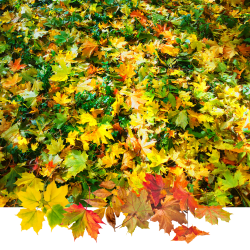
Autumn is your lawn’s favorite time of year! It’s the best time to treat your turf to a little extra maintenance, that will ensure a thick, green, healthy lawn next spring!
Remove the Leaves
“Leave the leaves” may be an excellent idea for your perennial beds and the ecosystem in general, but not for your lawn! Leaves block light and trap moisture. Those soggy mats of leaves on your turf can lead to disease problems. So as leaves fall, rake them from lawns and add them to the compost bin or shred them and dig directly into your vegetable garden.
Aerate to Loosen the Soil
Regular aeration prevents soil from becoming compacted and covered with a layer of thatch. Thatch blocks water, oxygen, and nutrients from reaching the soil. It’s a good idea to aerate your lawn BEFORE FERTILIZING, so the fertilizer will be able to reach the roots.
Apply Winter Fertilizer
Green Thumb Winterizer should be applied in mid October. This slow-release fertilizer will feed continuously for the next sixteen weeks, giving grass roots plant sugars to protect roots from freezing over the winter, and enough energy to bounce back in the spring.
Get Rid of the Weeds
In the autumn, weeds prepare for winter by sending energy and nutrients into their roots. It’s a good time to apply Weed Free Zone to kill these invasive weeds, roots and all. Make sure to remove weeds before they go to seed for the season, or you’ll see them again in the spring!
Grub Control
No, the Japanese Beetles haven’t gone away — they’ve burrowed into your turf for the winter! Early Autumn is the prime time to apply a grub control before the weather turns colder and they burrow deeper. GrubGONE! is a bio-insecticide that is effective at controlling turf grubs without side effects of off-target damage to beneficial insects.
Continue Watering
Continue to water as long as the temperatures remain above freezing, and always be sure to give your lawn a good watering before you drain your sprinkler systems for the year. While it’s true there is less evaporation at this time of year, natural moisture may not be enough to keep the grass roots hydrated and healthy going into the winter. Make sure your lawn continues to receive at least an inch of water a week.
Keep mowing
Grass will continue to grow up until the first hard frost. If you put the mower away too soon and allow the grass to become too long, it will mat, which can make it susceptible to fungi like snow mold. In the autumn, aim to maintain an ideal height of 2 ½”-3.” This is long enough to protect the root system over the winter, but not long enough to encourage disease. Regular mowing is also an easy way to chop up those fallen leaves for a natural, soil-enhancing mulch.
Reseed and Repair
The cooler temperatures of autumn make it an ideal time to thicken up existing turf. The soil is still warm, moisture doesn’t evaporate as quickly, nights are cooler, and the sun isn’t as hot during the day. This allows grass to grow more rapidly and gives it a chance to establish before cold weather arrives.
